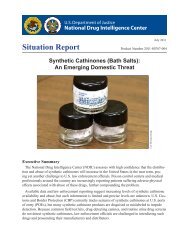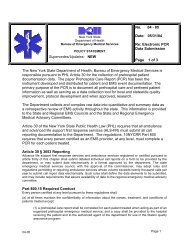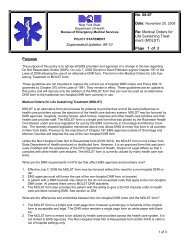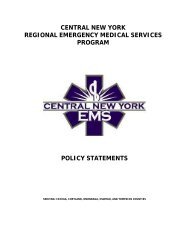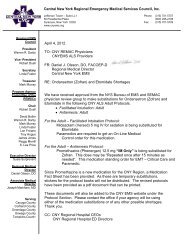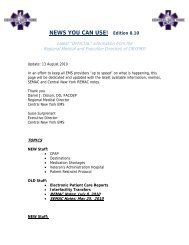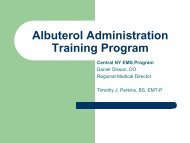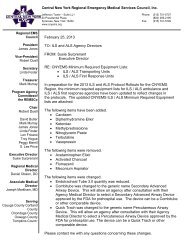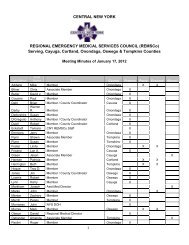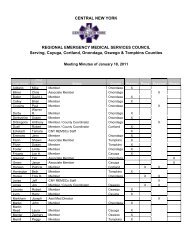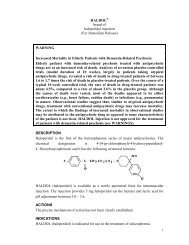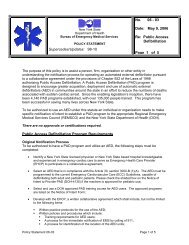Blood Glucose Measuring Devices in the Pre-Hospital ... - CNY EMS
Blood Glucose Measuring Devices in the Pre-Hospital ... - CNY EMS
Blood Glucose Measuring Devices in the Pre-Hospital ... - CNY EMS
Create successful ePaper yourself
Turn your PDF publications into a flip-book with our unique Google optimized e-Paper software.
<strong>Blood</strong> <strong>Glucose</strong> <strong>Measur<strong>in</strong>g</strong> <strong>Devices</strong><br />
<strong>in</strong> <strong>the</strong> <strong>Pre</strong>-<strong>Hospital</strong> Sett<strong>in</strong>g<br />
Collaboration by:<br />
Central NY R<strong>EMS</strong>CO<br />
F<strong>in</strong>ger Lakes R<strong>EMS</strong>CO<br />
Mid-State R<strong>EMS</strong>CO<br />
Monroe-Liv<strong>in</strong>gston R<strong>EMS</strong>CO<br />
North Country R<strong>EMS</strong>CO<br />
Susquehanna R<strong>EMS</strong>CO<br />
1
Purpose<br />
To prepare currently certified EMT-Basics to<br />
utilize a <strong>Blood</strong> <strong>Glucose</strong> measur<strong>in</strong>g device<br />
when operat<strong>in</strong>g under an approved <strong>EMS</strong><br />
agency and <strong>in</strong> accordance with NYS DOH<br />
Policy Statement 05-04 and regional<br />
protocols.<br />
2
Objectives<br />
• History of program<br />
• Understand<strong>in</strong>g Diabetes Mellitus<br />
• Physiology of hypoglycemia and hyperglycemia<br />
• Individual EMT skills<br />
• Indications for use<br />
• Demonstrate use of device<br />
• Act appropriately to f<strong>in</strong>d<strong>in</strong>gs<br />
• Sharps safety<br />
• Additional patient care<br />
• Agency responsibility<br />
3
Note<br />
Information with<strong>in</strong> this presentation<br />
should be tailored to <strong>the</strong> <strong>Blood</strong> <strong>Glucose</strong><br />
<strong>Measur<strong>in</strong>g</strong> Device used by <strong>the</strong> service and<br />
should <strong>in</strong>clude a review of <strong>the</strong><br />
manufacturer’s <strong>in</strong>structions.<br />
4
History<br />
5
Agency Responsibility<br />
• Any local or regional approvals<br />
• CLIA Waiver<br />
• Equipment acquisition<br />
• Tra<strong>in</strong><strong>in</strong>g and retention<br />
• Equipment calibration and<br />
ma<strong>in</strong>tenance<br />
6
History<br />
• Pilot Program with Albany<br />
FD.<br />
• Basic EMT’s <strong>in</strong>dependently<br />
used <strong>the</strong> glucometer 778<br />
times dur<strong>in</strong>g <strong>the</strong> study<br />
period<br />
• No blood borne pathogen<br />
exposures or sharps <strong>in</strong>juries<br />
occurred<br />
• Physician Medical Control<br />
available 24/7<br />
• No requests for Medical<br />
Control<br />
7
O<strong>the</strong>r States<br />
• Wiscons<strong>in</strong><br />
• Massachusetts<br />
• Nebraska<br />
• Virg<strong>in</strong>ia<br />
• Oklahoma<br />
• South Carol<strong>in</strong>a<br />
• Arizona<br />
Allow BLS Glucometer use<br />
8
Albany FD Learn<strong>in</strong>g & Retention<br />
• Practical Skill Evaluation<br />
• 111 Basic EMT’s<br />
• <strong>Pre</strong>test pass rate 100%<br />
• Post-test pass rate 100%<br />
• Protocol Evaluation Exam<br />
• 111 Basic EMT’s<br />
• <strong>Pre</strong>test pass rate 100%<br />
• Post-test pass rate 100%<br />
9
Study Results<br />
Can a EMT/B properly do a BG<br />
Of course <strong>the</strong>y can do it<br />
10
Physiology<br />
• The body uses glucose and oxygen to create energy<br />
• Glucagon functions to stimulate <strong>the</strong> liver to release<br />
stored glucose <strong>in</strong>to <strong>the</strong> bloodstream<br />
• The bloodstream distributes hormones throughout<br />
<strong>the</strong> body<br />
• The endocr<strong>in</strong>e system ma<strong>in</strong>ta<strong>in</strong>s homeostasis and<br />
responds to environmental stress<br />
• Without a proper glucose level, organs can<br />
malfunction<br />
• The bra<strong>in</strong> is very sensitive to glucose levels<br />
• Abnormal levels may result <strong>in</strong> permanent bra<strong>in</strong> cell<br />
death<br />
• Diabetes is a disease that affects more than 10<br />
million Americans<br />
11
<strong>Glucose</strong> / Insul<strong>in</strong> Balance<br />
• When normally balanced,<br />
body uses glucose for<br />
energy.<br />
• Fats and prote<strong>in</strong>s are less<br />
efficient fuels.<br />
• Insul<strong>in</strong> is released by <strong>the</strong><br />
beta cells of <strong>the</strong> pancreas.<br />
• When <strong>in</strong>sul<strong>in</strong> decreases,<br />
cells cannot use all glucose.<br />
• Insul<strong>in</strong> is a hormone.<br />
• <strong>Glucose</strong> spills <strong>in</strong>to ur<strong>in</strong>e.<br />
• Ur<strong>in</strong>e output <strong>in</strong>creases.<br />
• Patient becomes thirsty.<br />
12
What is a “Diabetic”<br />
• The condition where<br />
<strong>the</strong> pancreas<br />
produces <strong>in</strong>sufficient<br />
<strong>in</strong>sul<strong>in</strong> is “diabetes<br />
mellitus”.<br />
• A patient suffer<strong>in</strong>g<br />
from this condition is<br />
“diabetic”.<br />
13
Bra<strong>in</strong> Cell Metabolism<br />
• Bra<strong>in</strong> cells do not need <strong>in</strong>sul<strong>in</strong> to utilize<br />
glucose.<br />
• They do, however, need adequate levels of<br />
glucose <strong>in</strong> order to function properly!<br />
• When glucose levels drop too low, <strong>the</strong><br />
bra<strong>in</strong> cells cease to function normally and<br />
changes <strong>in</strong> behavior and LOC follow.<br />
• There is no “set” level at which patients<br />
show S/S of low blood glucose as it differs<br />
from person to person<br />
14
Normal <strong>Blood</strong> <strong>Glucose</strong> Levels<br />
• Normal ranges for blood glucose levels:<br />
• Infant<br />
• Child < 2 years<br />
• Child > 2 years to Adult<br />
• Adult<br />
(40 – 90 mg/dl)<br />
(60 – 100 mg/dl)<br />
(70 – 105 mg/dl)<br />
(70 – 105 mg/dl)<br />
• Elderly patients (50 y/o +) often have a slightly<br />
elevated blood glucose level, but should not<br />
normally exceed 126 mg/dl.<br />
• These read<strong>in</strong>gs will be altered by time of<br />
day and last oral <strong>in</strong>take. Values reflected<br />
are fast<strong>in</strong>g values.<br />
15
Decreased <strong>Blood</strong> <strong>Glucose</strong> Levels<br />
• Indicative of several potential processes:<br />
• Insul<strong>in</strong>oma<br />
• Hypothyroidism<br />
• Addison’s disease<br />
• Extensive liver disease<br />
• Hypopituitarism<br />
• Pancreatic disease or cancer<br />
If untreated can lead to<br />
• Insul<strong>in</strong> Shock<br />
• Unconsciousness<br />
• Permanent bra<strong>in</strong> damage<br />
16
Result<strong>in</strong>g from<br />
• Too much <strong>in</strong>sul<strong>in</strong>, wrong dose<br />
• Took regular dose of <strong>in</strong>sul<strong>in</strong> but<br />
didn’t eat enough food<br />
• Had an unusual amount of activity or<br />
vigorous exercise<br />
• Sick, feverish<br />
17
Increased <strong>Blood</strong> <strong>Glucose</strong> Levels<br />
• Indicative of several potential processes:<br />
• Diabetes mellitus<br />
• Acute stress response<br />
• Cush<strong>in</strong>g’s disease<br />
• Diuretic <strong>the</strong>rapy<br />
• Corticosteroid <strong>the</strong>rapy<br />
• If untreated can lead to<br />
• Diabetic Ketoacidosis (DKA)<br />
• Dehydration Diabetic Coma<br />
• Dehydration results from a process called osmotic diuresis<br />
• Death or bra<strong>in</strong> damage<br />
18
Result<strong>in</strong>g from<br />
• Too little a dose of <strong>in</strong>sul<strong>in</strong><br />
• Dose no longer controls levels<br />
• Too much sugar <strong>in</strong>take<br />
• Enough food was eaten but forgot to<br />
take <strong>in</strong>sul<strong>in</strong><br />
19
Diabetes Type I<br />
• Usually juvenile onset<br />
• May have onset after<br />
pancreatic trauma /<br />
disease<br />
• Insul<strong>in</strong> is not produced<br />
• Usually take Insul<strong>in</strong><br />
<strong>in</strong>jections<br />
20
Diabetes – Type II<br />
• Usually adult onset…<br />
• Produce <strong>in</strong>sul<strong>in</strong> – but not<br />
enough<br />
• Usually take oral meds to<br />
stimulate <strong>in</strong>sul<strong>in</strong> production<br />
• If severe enough, <strong>in</strong>sul<strong>in</strong><br />
<strong>in</strong>jections may be necessary<br />
• Changes <strong>in</strong> diet necessary<br />
• Less likely to experience<br />
hypoglycemic episodes<br />
21
Gestational Diabetes<br />
• Def<strong>in</strong>ition: Onset of diabetes with pregnancy.<br />
• Most women need two to three times more<br />
<strong>in</strong>sul<strong>in</strong> when <strong>the</strong>y are pregnant than <strong>the</strong>y<br />
usually do.<br />
• In gestational diabetes, <strong>the</strong>re are often no<br />
warn<strong>in</strong>g symptoms. All pregnant women need<br />
to be tested for diabetes dur<strong>in</strong>g <strong>the</strong> second<br />
trimester. This is especially important for<br />
women who are already at risk.<br />
• After <strong>the</strong> baby is born, blood glucose levels<br />
usually return to normal. A woman who has<br />
had gestational diabetes is at risk for<br />
develop<strong>in</strong>g type 2 diabetes later <strong>in</strong> life.<br />
22
Unrecognized or Untreated...<br />
• Diabetes is a time bomb!<br />
• Diabetes leads to:<br />
• Weakness<br />
• Weight Loss<br />
• Heart Disease<br />
• Kidney Disease<br />
• Bl<strong>in</strong>dness<br />
• Death….<br />
23
Insul<strong>in</strong> Pump<br />
24
“So what makes diabetes a medical<br />
emergency”<br />
Hypo (low) glycemia (blood sugar)<br />
• Hypo (low) glycemia (blood sugar)<br />
• Too much <strong>in</strong>sul<strong>in</strong> <strong>in</strong> blood.<br />
• Not enough sugar for bra<strong>in</strong> Hyperglycemia<br />
Hyper (high) glycemia (blood sugar)<br />
• Too much sugar <strong>in</strong> blood.<br />
• Not enough <strong>in</strong>sul<strong>in</strong> <strong>in</strong> system to let glucose <strong>in</strong>to<br />
cells.<br />
25
Cl<strong>in</strong>ical <strong>Pre</strong>sentation<br />
Hypoglycemia<br />
(BG < Normal)<br />
• Normal or rapid<br />
respirations<br />
• Pale, moist sk<strong>in</strong><br />
• Diaphoresis<br />
• Dizz<strong>in</strong>ess, headache<br />
• Rapid pulse<br />
• Normal or low BP<br />
• Altered mental status<br />
• Anxious or combative<br />
• Seizure or fa<strong>in</strong>t<strong>in</strong>g<br />
• Coma<br />
• Weakness simulat<strong>in</strong>g CVA<br />
Hyperglycemia<br />
(BG > 200 mg/dl)<br />
•Kussmaul respirations<br />
•Dehydration with dry, warm sk<strong>in</strong><br />
and sunken eyes<br />
•Polydipsia: excessive thirst<br />
•A sweet or fruity (acetone) odor to<br />
breath<br />
•Polyphagia: excessive hunger<br />
•Poor wound heal<strong>in</strong>g<br />
•Rapid and weak pulse<br />
•Polyuria: excessive ur<strong>in</strong>ation<br />
•Blurred vision, fatigue<br />
•Normal or slightly low BP<br />
•Vary<strong>in</strong>g degrees of<br />
unresponsiveness that onsets more<br />
slowly than <strong>in</strong> hypoglycemia<br />
26
Glucometry<br />
• Indications to perform glucose test<br />
• How to obta<strong>in</strong> blood sample<br />
• Instruction on glucometer operation<br />
• What to do with test result<br />
• Proper disposal of sharps /<br />
contam<strong>in</strong>ants<br />
• Proper action for blood borne<br />
pathogen exposure<br />
27
Indications for BG <strong>Measur<strong>in</strong>g</strong><br />
Signs and Symptoms consistent with<br />
• Acute Stroke<br />
• Weakness, slurred speech<br />
• Altered Mental Status<br />
• Confusion, disorientation<br />
• Diabetic Emergencies<br />
28
Altered Mental Status –<br />
Common Causes<br />
AEIOU-TIPS<br />
• Alcoholism<br />
• Epilepsy<br />
• Insul<strong>in</strong><br />
• Overdose<br />
• Underdose<br />
• Trauma<br />
• Infection<br />
• Psychiatric<br />
• Stroke/Seizure<br />
29
But First!!!!<br />
• ABC’s<br />
• Vitals Signs<br />
• O2 Adm<strong>in</strong>istration<br />
• SPO2 if available<br />
• Complete SAMPLE history<br />
• Good BLS Comes First…………..<br />
30
BLS <strong>Pre</strong>-<strong>Hospital</strong> Care<br />
Scene Safety/Survey<br />
Perform <strong>in</strong>itial assessment<br />
May require airway control, def<strong>in</strong>itely oxygen<br />
Ensure cervical sp<strong>in</strong>e immobilization as <strong>in</strong>dicated<br />
Activate ALS!<br />
31
BLS <strong>Pre</strong>-<strong>Hospital</strong> Care<br />
Perform focused history and physical exam<br />
SAMPLE history<br />
Signs/Symptoms (when did <strong>the</strong>y start; how long did<br />
<strong>the</strong>y last)<br />
Allergies<br />
Medications (When last taken)<br />
Prior Medical History (diabetes, seizure disorder)<br />
Last oral <strong>in</strong>take (When did patient last eat)<br />
Events lead<strong>in</strong>g to illness/<strong>in</strong>jury<br />
32
BLS <strong>Pre</strong>-<strong>Hospital</strong> Care<br />
Focused history & physical exam, cont.<br />
Take base l<strong>in</strong>e vital signs<br />
Determ<strong>in</strong>e blood glucose level<br />
Evidence of hypo<strong>the</strong>rmia or hyper<strong>the</strong>rmia<br />
Can <strong>the</strong> patient swallow normally<br />
33
On-Go<strong>in</strong>g Assessment<br />
Is <strong>the</strong> patient’s mental status improv<strong>in</strong>g<br />
Reassess ABCs,<br />
Monitor VS every 5 m<strong>in</strong>utes if unstable; every 15<br />
m<strong>in</strong>utes if stable.<br />
Carefully document your assessment f<strong>in</strong>d<strong>in</strong>gs.<br />
Notify <strong>in</strong>com<strong>in</strong>g ALS unit or receiv<strong>in</strong>g hospital as<br />
soon as possible<br />
34
Common Diabetic Emergencies<br />
• Hypoglycemia<br />
• Hyperglycemia<br />
35
Hypo vs Hyper<br />
Hyper<br />
Hypo<br />
Onset 12-48 hours
Hypoglycemia<br />
• “Looks Shocky” used to be called<br />
Insul<strong>in</strong> shock. Pale, diaphoretic,<br />
altered mental status. May Vomit.<br />
• BG
Emergency Treatment<br />
• Hypoglycemia<br />
• Scene size up & BSI<br />
• Initial Assessment with O 2<br />
• Determ<strong>in</strong>e need for rapid transport<br />
• Focused H&P Medical with vitals<br />
• <strong>Blood</strong> glucose check<br />
• If < 80 mg/dl, give oral glucose if LOC <strong>in</strong>tact<br />
• If < 80 mg/dl and LOC is ↓, activate ALS assistance<br />
• Detailed, on-go<strong>in</strong>g assessments with transport to<br />
appropriate facility<br />
• Supportive care as needed<br />
38
Treatment for Hypoglycemia<br />
• Oral <strong>Glucose</strong> only if <strong>the</strong>y can<br />
swallow on command, o<strong>the</strong>rwise<br />
protect airway<br />
• Never assume it is a hypoglycemic<br />
episode until BG is done.<br />
• Never Assume that Hypoglycemia is<br />
only problem.<br />
39
Emergency Treatment<br />
• Hyperglycemia<br />
• Scene size up and BSI<br />
• Initial Assessment with O 2 and determ<strong>in</strong>e need for rapid<br />
transport<br />
• Focused H&P Medical with vitals<br />
• Monitor blood glucose level<br />
• If blood glucose is > 200 mg/dl <strong>the</strong> patient may need rehydration<br />
and <strong>in</strong>sul<strong>in</strong> per physician direction<br />
• Consider ALS Assistance if vitals signs compromised<br />
• Detailed, on-go<strong>in</strong>g assessments with transport to<br />
appropriate facility<br />
• Supportive care as needed<br />
40
<strong>Glucose</strong> <strong>Measur<strong>in</strong>g</strong> <strong>Devices</strong><br />
• Used to check <strong>Blood</strong> Sugar Levels.<br />
• Many different types and models.<br />
41
Use of Glucometer<br />
• Equipment needed:<br />
• Exam gloves<br />
• Alcohol prep pads<br />
• Glucometer<br />
• Test strips<br />
• Cotton balls or gauze<br />
pads<br />
• Band-aid<br />
• Lancets<br />
• Sharps conta<strong>in</strong>er and<br />
proper waste disposal<br />
conta<strong>in</strong>er<br />
42
Procedures<br />
• Careful attention to BSI & safety<br />
• Select F<strong>in</strong>ger<br />
• Massage blood <strong>in</strong>to distal end<br />
• Clean f<strong>in</strong>ger with alcohol & allow to dry<br />
• Use Auto-lancet device<br />
• Apply drop of blood onto test strip and<br />
follow <strong>in</strong>dividual glucometer <strong>in</strong>structions<br />
• Dispose of sharps and soiled supplies<br />
43
Device Variations<br />
• Some glucometers turn on automatically.<br />
• Know <strong>the</strong> features of <strong>the</strong> glucometer your service<br />
uses.<br />
44
Patient <strong>Pre</strong>paration<br />
• Clean <strong>the</strong> site;<br />
• Use a f<strong>in</strong>ger tip on <strong>the</strong> non-dom<strong>in</strong>ant hand<br />
45
Cleanse sk<strong>in</strong> with alcohol prep<br />
46
BG Procedure<br />
•The glucometer read<strong>in</strong>g <strong>in</strong>dicates <strong>the</strong> amount of<br />
glucose <strong>in</strong> <strong>the</strong> patient’s blood stream.<br />
47
What Now<br />
Treat <strong>the</strong> Patient<br />
Document Results<br />
Proper disposal of sharps<br />
48
Adm<strong>in</strong>ister<strong>in</strong>g <strong>Glucose</strong><br />
• If <strong>the</strong> patient is alert enough, let <strong>the</strong>m<br />
squeeze oral glucose <strong>in</strong>to her mouth<br />
49
Adm<strong>in</strong>ister<strong>in</strong>g Oral <strong>Glucose</strong><br />
• Make sure <strong>the</strong><br />
tube is <strong>in</strong>tact and<br />
has not expired.<br />
• Squeeze a<br />
generous amount<br />
onto a bite stick.<br />
50
Adm<strong>in</strong>ister<strong>in</strong>g <strong>Glucose</strong><br />
• Open <strong>the</strong> patient’s<br />
mouth.<br />
• Place <strong>the</strong> bite stick on<br />
<strong>the</strong> mucous<br />
membranes between<br />
<strong>the</strong> cheek and <strong>the</strong> gum<br />
with <strong>the</strong> gel side next to<br />
<strong>the</strong> cheek.<br />
• Repeat as needed.<br />
• Usual dose of oral<br />
glucose is one tube.<br />
51
Ma<strong>in</strong>tenance<br />
• Set up requires identification of:<br />
• Proper batch numbers for test strips<br />
• Rout<strong>in</strong>e control test<strong>in</strong>g<br />
• Calibration when necessary<br />
• Follow CLIA guidel<strong>in</strong>es<br />
• Log daily (shift) test<strong>in</strong>g<br />
• Follow manufacturer’s directions<br />
52
Care of <strong>the</strong> <strong>Blood</strong> Glucometer<br />
• Handle with care!<br />
• Do NOT expose to excessive heat,<br />
humidity, cold, dust, or dirt<br />
• Clean as directed by manufacturer<br />
• Store <strong>the</strong> glucometer <strong>in</strong> <strong>the</strong> case<br />
provided by <strong>the</strong> manufacturer<br />
53
<strong>Blood</strong> Glucometer Errors<br />
Can result from:<br />
• Wrong calibration of glucometer.<br />
• Lack of glucometer ma<strong>in</strong>tenance and<br />
clean<strong>in</strong>g.<br />
• Battery failure.<br />
• Test strip failure.<br />
* Proper care and ma<strong>in</strong>tenance of<br />
glucometers can help prevent<br />
<strong>the</strong>se errors.<br />
54
Case Study 1<br />
• Your unit receives a call for an<br />
<strong>in</strong>sul<strong>in</strong> reaction. You f<strong>in</strong>d, upon<br />
arrival, a 44 year old female patient<br />
who presents giddy and nervous.<br />
The family states that she is an<br />
<strong>in</strong>sul<strong>in</strong> dependent diabetic who had<br />
her <strong>in</strong>sul<strong>in</strong> today and has not eaten.<br />
What are <strong>the</strong> treatment steps for this<br />
patient<br />
55
Case Study 2<br />
• Your unit receives a call for an<br />
unconscious subject. Upon arrival at <strong>the</strong><br />
bus<strong>in</strong>ess, you f<strong>in</strong>d a 22 year old male<br />
patient who is sup<strong>in</strong>e on <strong>the</strong> floor and<br />
unresponsive. There is vomitus on <strong>the</strong><br />
floor beside him and around his mouth. He<br />
is breath<strong>in</strong>g and has a strong pulse. He<br />
has no identification or medic alert tags<br />
on him. What are your treatment steps for<br />
this patient<br />
56
Case Study 3<br />
• Your unit receives a call for a traffic crash.<br />
Upon arrival you f<strong>in</strong>d an elderly patient<br />
beh<strong>in</strong>d <strong>the</strong> wheel of a car that has gone off<br />
of <strong>the</strong> road and is up aga<strong>in</strong>st a tree by a<br />
creek. The patient presents unresponsive,<br />
but with no specific signs of <strong>in</strong>jury. Vitals<br />
are stable except for <strong>the</strong> decreased LOC,<br />
which is found to be responsive to pa<strong>in</strong>ful<br />
stimuli. What are your treatment steps for<br />
this patient<br />
57
Case Study 4<br />
• Your unit responds to a home for <strong>the</strong><br />
report of a diabetic who is found<br />
unresponsive. You f<strong>in</strong>d <strong>the</strong> patient<br />
unresponsive and breath<strong>in</strong>g shallow. Sk<strong>in</strong><br />
is warm and dry. Vitals are with<strong>in</strong> normal<br />
limits. The patient, a 77 year old female is<br />
an <strong>in</strong>sul<strong>in</strong> dependent diabetic who has<br />
eaten today, but it is unknown if she had<br />
her <strong>in</strong>sul<strong>in</strong>. What are your treatment steps<br />
for this patient<br />
58
QUESTIONS<br />
59



